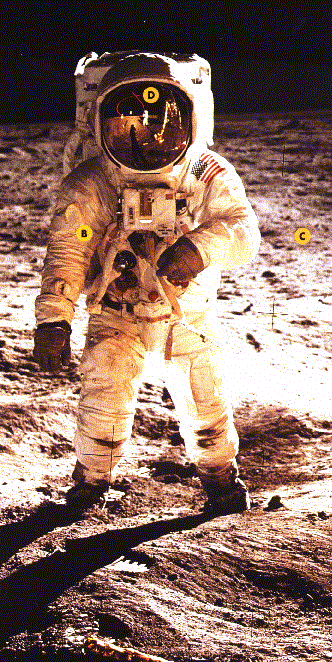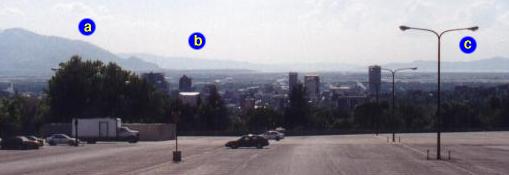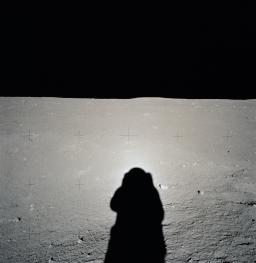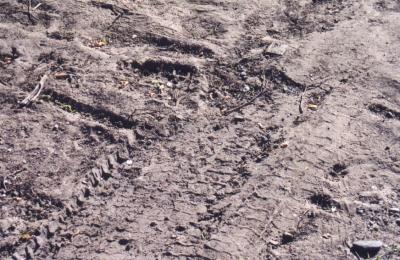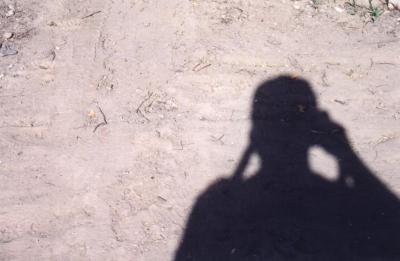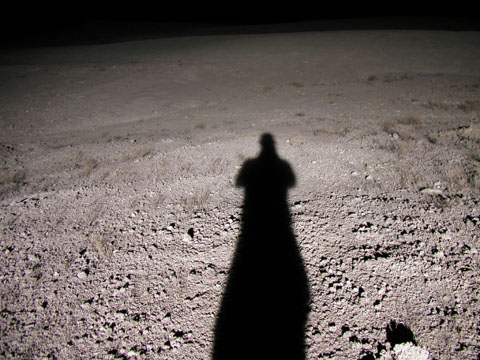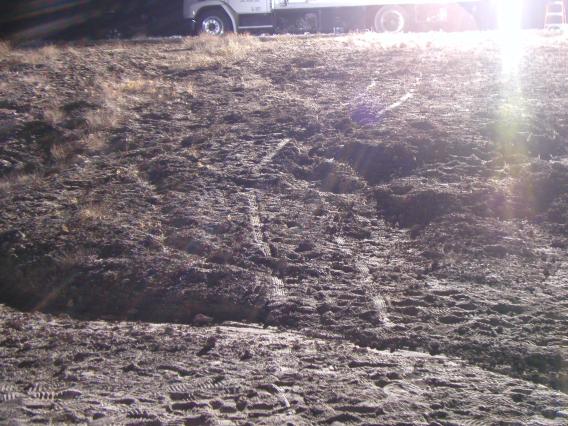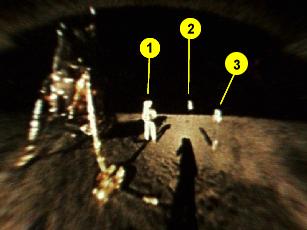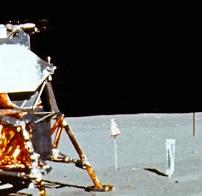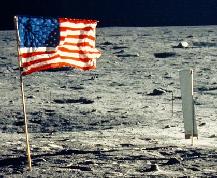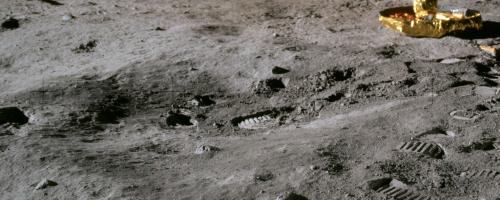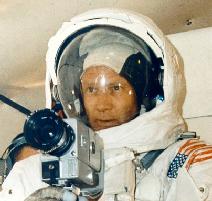man on the moon







|
|
|
The darkness at the horizon has a different explanation (see below) that has nothing to do with the presence or absence of atmosphere.
 The "falloff" around
Aldrin -- especially at the horizon -- and the pool of light directly
behind Aldrin prove that he is standing in the beam of a
spotlight. If this were real sunlight, the lunar surface should be
evenly lit. [Mary Bennett, David Percy, et al.]
The "falloff" around
Aldrin -- especially at the horizon -- and the pool of light directly
behind Aldrin prove that he is standing in the beam of a
spotlight. If this were real sunlight, the lunar surface should be
evenly lit. [Mary Bennett, David Percy, et al.]
|
The effect is seen too in Fig. 3, which is the photo taken just prior to Fig. 1.
The conspiracists are no doubt thinking of the difference between natural sunlight and artificial light. Consider a flat, level surface such as a parking lot. Without obstructions, each parking space is equally illuminated by the sun. The sun is no brighter at one end of the parking lot than it is at the other. Now consider the same parking lot at night, lit by its overhead street lamps. Those spaces nearest the lamps will be brighter than the ones farther away. This is likely the basis underlying Bennett's and Percy's photo "rule" #4 (Dark Moon, p. 35).
Light intensity is governed by an inverse square law, meaning the intensity decreases according to the square of the increase in distance away from the light -- if you double the distance, the light is only one-fourth as bright. For nearby lights such as street lamps, this is significant. For faraway lights like the sun, the difference in distance across a parking lot is inconsequential compared to the distance between the sun and the entire parking lot.
But the inverse square law is not the only law at work in these pictures. And the amount of light arriving per unit area does not universally determine the brightness of any particular spot in a photograph of that area.
|
The amount of light a surface receives from the sun depends on the angle at which it receives it. Textured surfaces such as the lunar surface in this photo are composed of thousands of small facets, each facing a slightly different direction with respect to the sun and each therefore receiving a different amount of sunlight. This isn't true in the parking lot example, but it's the case here.
Because the moon is smaller than Earth, the surface curves away faster at the horizon. The surface is literally falling away from the photographer in Fig. 1. This decreases the illumination angle for the whole surface in general, not just the individual texture facets.
In Figs. 1 and 3 the camera is looking generally into the sun. That means it's seeing the shaded side of texture elements (little hills, rocks, etc.) that are obviously much darker than the sunlit sides. When you look into the sun, and the sun is at a low angle, surface texture looks dark because you're seeing the cumulative effect of all those shaded texture facets.
When you look in the same direction as the sun's rays travel, you see only the lighted portions of these texture elements. The shaded portions are facing away from you, and the texture elements are hiding their own shadows. This presents the illusion of a uniformly bright surface (Fig. 4).
We can verify this on Earth.
|
|
Figures 5 and 6 were taken of the same patch of ground with the same camera settings and lighting (sunlight), but from two utterly different directions. Looking in the up-sun direction we can see the tire tracks and other texture elements because the shaded side of them is facing the camera. In Figure 6, the texture is largely invisible because no lighting variations exist to reveal contour. Further, Fig. 6 has a much "brighter" feel than Fig. 5.
Fig. 7 shows what happens when we try to duplicate Fig. 4 with an 18 kW spotlight, as Bennett and Percy say must have been done to create those photographs.
|
While in the Apollo photograph the surface is bright all the way to the horizon (and in fact is brighter at the horizon because of the lighting phase angle we have just explained), the scene lit with the artificial light is dimmest at the horizon.
Note in the foreground of Fig. 2 that the surface has been churned up by astronaut footprints. We noticed that this not only produces texture that creates additional small-scale shading and the accompanying apparent darkness, it also stirs up subsurface dust, which was observed to be darker in color than surface dust.
We still have not explained the extraordinary bright pool of light behind Aldrin in Fig. 1. This is an area that was swept by the LM's exhaust as it landed. Aldrin reported a few seconds before touchdown that the LM was "drifting to the right a little," and Armstrong overcorrected by sliding the LM sideways to the left. It was moving leftward and slightly forward when it struck the ground. The bright spot in Figs. 1 and 3 are where the exhaust plume erased some of the texture elements and smoothed out the surface.
|
As Fig. 8 demonstrates, where you smooth out the texture you reduce the amount of shadow that texture can produce, and thereby reduce the apparent darkness of the surface. Because the spot behind Aldrin is smoother than its surroundings, it appears brighter especially when photographed up-sun.
 Note D: The item circled
in red cannot be accounted for.
Note D: The item circled
in red cannot be accounted for.
Some conspiracists maintain this circled item is an alien structure on the moon, invisible to the astronauts because of their visors. In fact, it's just the American flag.
|
Markus Mehring, a contributor to the Apollo Lunar Surface Journal, has enlarged the reflection in the visor, reversed it from its mirror image, and corrected for the spherical distortion of the visor (Fig. 9).
We have numbered the interesting items in the reflection in Aldrin's faceplate:
- Neil Armstrong taking the photo.
- The United States flag.
- The solar wind experiment.
Numerous photos show the relationship of the solar wind experiment to the flag on the Apollo 11 landing site. (See the photos below.) The supposedly mysterious object is exactly in the place where we would expect to see the flag. The solar wind experiment is often mistaken for the flag because it appears to be a bulky object atop a thin support. In fact the silvery material of the solar wind collector is reflecting the lunar surface; the shadow cast behind it clearly shows it to be the long, rectangular item we understand to be the solar collector.
|
It's true that the visors were difficult to see through. However, the astronauts reported no significant impairment to their vision. The Apollo 11 astronauts egressed in shadow and were able to see in the shadow quite adequately. When they moved from sunlight to shadow, it took a few minutes for their eyes to adjust. Apollo 17 astronaut Jack Schmidt even raised his visor on occasion because it was scratched with dust.
So the notion that a mysterious structure bright enough to show up clearly on a photograph was completely invisible to the astronauts (and indeed remains invisible to earth astronomers) is entirely far-fetched.
 Comparing the reflection
of the horizon with the actual horizon, it is clear this picture was
not taken from a camera at chest level. [Mary Bennett and David
Percy]
Comparing the reflection
of the horizon with the actual horizon, it is clear this picture was
not taken from a camera at chest level. [Mary Bennett and David
Percy]
But as discussed above, the terrain is not flat and level. Even small variations in the surface would compromise this line of reasoning.
Aldrin is clearly standing in a small crater (Fig. 11), but even if that crater is only four or five inches (10 cm) deep, and even if Neil Armstrong is elevated no more than four or five inches (10 cm) above the surrounding terrain, that would still put Aldrin's visor level with the chest-mounted camera. The camera mount is actually much higher than the chest. It's at about shoulder level. Armstrong and Aldrin were the same height.
|
Below (Fig. 12) are two photos of Neil Armstrong (left) and Buzz Aldrin (right) training with the chest-mounted cameras. You can see how high up on the chest they ride, and how little difference there is between the camera mounted on the RCU and a camera held in the hand at eye level.
|
 The largest crosshair
should be in the exact center of the photograph, but in this photo it
is off-center. [Mary Bennett and David Percy, Dark Moon,
p. 68]
The largest crosshair
should be in the exact center of the photograph, but in this photo it
is off-center. [Mary Bennett and David Percy, Dark Moon,
p. 68]
See here.
